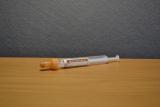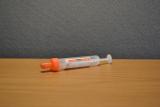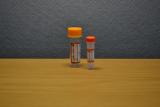Test Directory
C-peptide
Containers - Adult

Brown Cap, Gel Clotted
|
Volume Range
1.0 ml
Additive per Container
None |

Orange Cap
|
Volume Range
1.0 ml
Additive per Container
Lithium-heparin |
Containers - Child

Orange Cap - Paediatric
|
Volume Range
0.50 ml
Additive per Container
Lithium Heparin |
Reference ranges
See General additional information
Laboratory Site
WGH
Crewe Road South
Edinburgh
EH4 2XU
Edinburgh
EH4 2XU
Telephone (Biochemistry): 0131 537 1910/1
Transport arrangements
Samples should arrive with the laboratory on the same day as collection (C-peptide is stable for 8 hours at room temperature and 48 hours if refrigerated).
Anticipated turnaround
7 days
General additional information
Interpretation of C-peptide results
A reference range for C-peptide is not provided because in most circumstances when C-peptide is requested it is not useful to compare the result with the range found in a normal healthy population.
C-peptide levels reflect output of insulin from pancreatic β-cells and are extensively used in research however translation into clinical practice is ongoing. The use of C-peptide in selected patient groups is described below. Please note that C-peptide is excreted in the urine and therefore renal failure will increase the concentration of C-peptide in blood.
Investigation of hypoglycaemia
Paired measurement of glucose and insulin are required for the investigation of hypoglycaemia. C-peptide is only useful in the differential diagnosis of proven hyperinsulinaemic hypoglycaemia. See the website entry for insulin for further details.
Type 1 diabetic patients
Measurement of C-peptide may be used as a screening test in patients with a presumptive diagnosis in patients 3+ years following diagnosis. It should NOT be measured during an episode of DKA due to possible toxicity towards pancreatic cells, or within 3 years of presentation due to “honeymoon period” preservation of β-cell function. For full guidance on requesting and interpretation see the Diabetes Diagnostic pathway on the Edinburgh Centre for Endocrinology and Diabetes (ECED) website at www.edinburghdiabetes.com/diabetes-protocols.
Type 2 diabetic patients
Measurement of C-peptide is NOT currently advised to inform which treatment is most appropriate in Type 2 diabetic patients (eg insulin versus oral hypoglycaemics). This is likely to form the focus of future work.
For further information on the potential for biotin interference please click here.